Patchin Place, a dead end squeezed onto the north side of West 10th Street between 6th Avenue and Greenwich Avenue, has its own intrinsic charms, but it’s notable because Manhattan has not had a great deal of dead-end alleys since 1900 at least, and likely long before that. Manhattan, which has always been paved over and rebuilt upon relentlessly, has given up many of its alleyways, some picturesque, some slummy and dangerous. This space is landmarked, so it’ll likely be here as long as Manhattan exists.
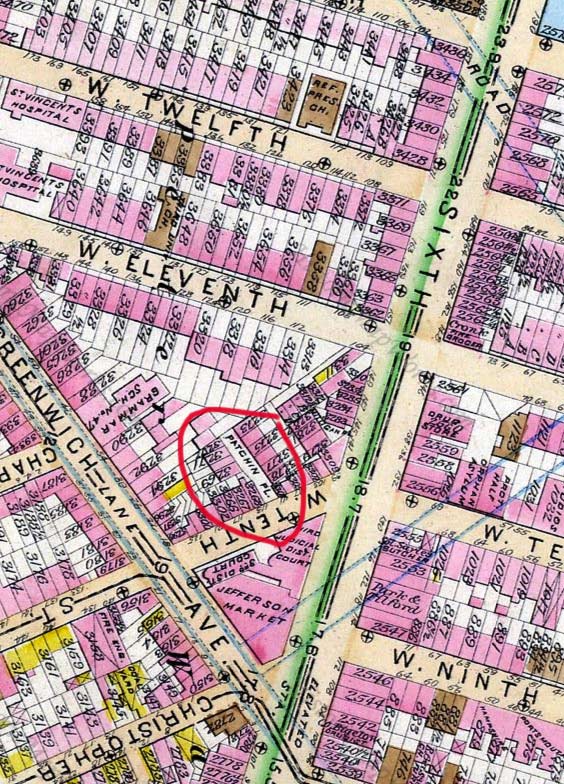
Patchin Place was created in 1848 or 1849 when Samuel Milligan, the owner of the parcel, decided to build ten townhouses facing each other across an alley. One (#4 Patchin Place) was built as a standalone building, with the rest attached to each other. Milligan’s daughter Isobel married his surveyor, Aaron Patchin, and his name was affixed to the alley, though it doesn’t turn up on maps by name until about 1885 (above). A smaller cul-de-sac issuing from 6th Avenue around the corner was named Milligan Place. It has been thought that the houses were originally built to house (mostly) Basque waiters at the now-demolished Brevoort Hotel on 5th Avenue, but the Brevoort was built in 1855. However the alley may well have been occupied by the workers at some point.
 When Patchin Place and its houses were built by 1849, West 10th Street was still known as Amos Street: the principal heir of Sir Peter Warren, who owned the land in the colonial era, was Charles Christopher Amos, and those names were applied to streets when they were built through the area by 1800. Amos Street became West 10th Street in 1857.
When Patchin Place and its houses were built by 1849, West 10th Street was still known as Amos Street: the principal heir of Sir Peter Warren, who owned the land in the colonial era, was Charles Christopher Amos, and those names were applied to streets when they were built through the area by 1800. Amos Street became West 10th Street in 1857.
Patchin Place is closed to traffic, but it’s built conventionally with a roadbed lined by two sidewalks. In the past, it’s possible that horses and carriages entered the alley and autos backed in and out, but that hasn’t been the case as long as I’ve known about Patchin Place. A gate sees to it that no cars enter, but the latch is usually open on the sidewalks to allow idlers and photographers like me to enter, as well as actual residents.
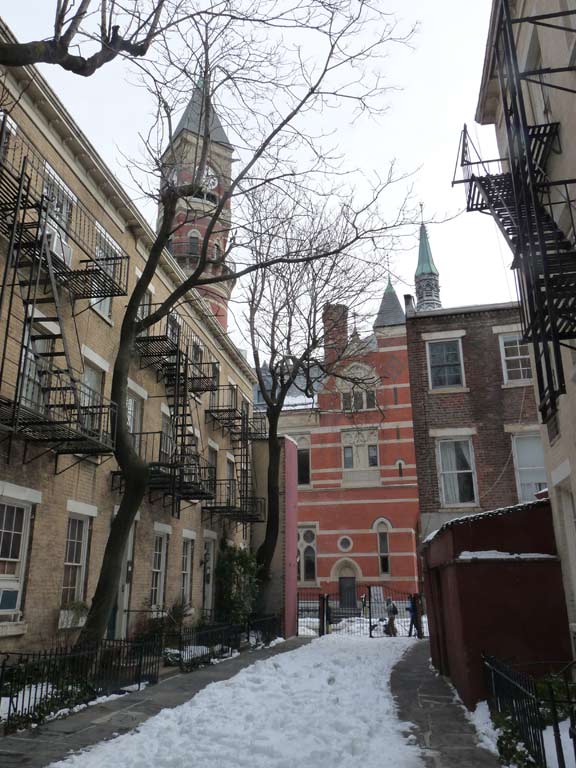
The view from the rear of Patchin Place shows off the clock tower of the Jefferson Market Courthouse, which used to house a court hearing women’s cases as well as a prison. Currently it is the home of the Jefferson Market Library. It’s a very interesting, fanciful structure and an example of a genre known as Ruskinian Gothic, named for an author who championed the style.
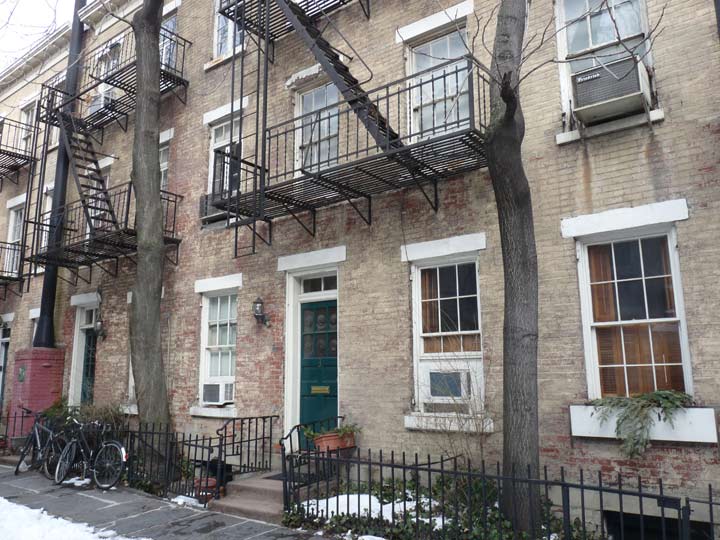
Before Communist totalitarian governments enslaved half the planet in the 20th Century, writers like journalist John Reed (1887-1920) championed the Marxist way and lionized the Russian revolution of 1918 that overthrew the czarate. Reed lived at #1 Patchin Place while writing his chronicle Ten Days That Shook the World. Reed was played in the 1980 movie Reds by Warren Beatty.
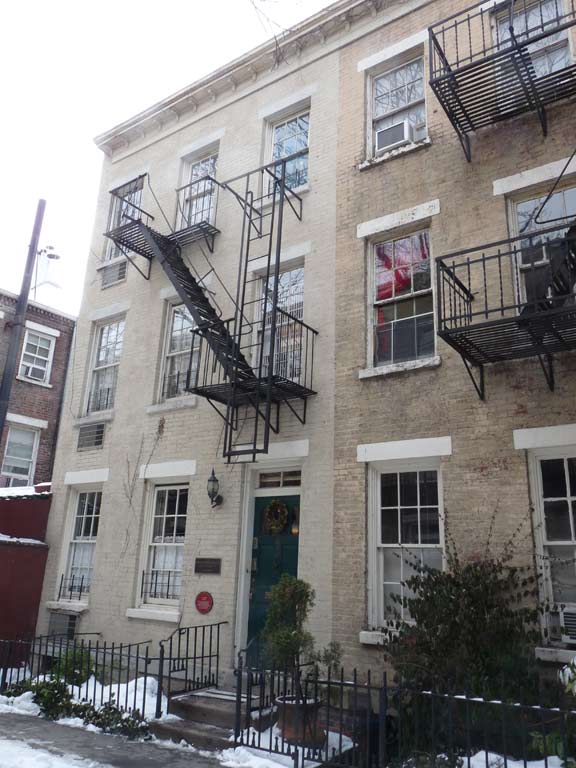
Though Patchin Place has hosted many writers, musicians and artists over the years, the standalone #4 Patchin is the only one that has received a plaque (actually two, with the newer one installed by the Historic Districts Council). Edward Estlin Cummings, poet, painter, essayist, author, and playwright (1894-1962) lived at #4 for many years. In a diametric opposition to John Reed, e.e. cummings was a McCarthyite Republican for much of his career.
“Buffalo Bill’s”
Buffalo Bill ‘s defunct
who used to
ride a watersmooth-silver
stallion and break onetwothreefourfive pigeonsjustlikethat
Jesus he was a handsome man
and what i want to know is
how do you like your blueeyed boy
Mister Death
(I can’t do the proper indentation and wordspacing in WordPress, but distinctive typography, and the lack of capitalization, were trademarks of his style, especially in later years. cummings was supposedly America’s most widely-read poet by 1962, with the first being Robert Frost.) He was a close friend of writer and cartoonist Djuna Barnes (1892-1982), who lived across the alley at #5 Patchin. Her novel Nightwood was frank in its depiction of homosexuality.
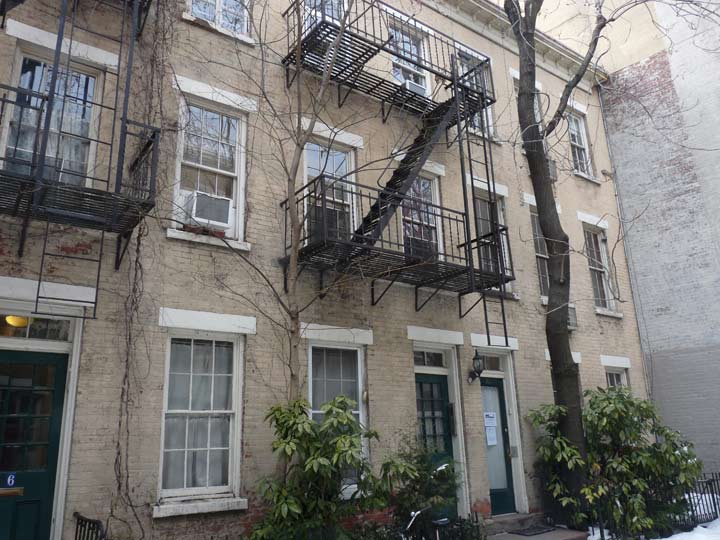
Above: 6, 8 and 10 Patchin Place.
Author Theodore Dreiser (1871-1945), of Sister Carrie and An American Tragedy fame, also resided in Pathcin Place, though unlike Reed, Barnes and Cummings I’m unsure of the exact address. Dreiser lived in many apartments around Greenwich Village. Dreiser leaned left, and his work often came under fire because of its sexual themes. An American Tragedy was filmed as A Place in the Sun, starring Montgomery Clift, Shelley Winters and Elizabeth Taylor. He was a close friend of Baltimore essayist H.L. Mencken.
Contrary to what you might read elsewhere, Marlon Brando did not live in Patchin Place; but his sister did, and put him up in 1943 when his theatrical and celluloid career was starting.
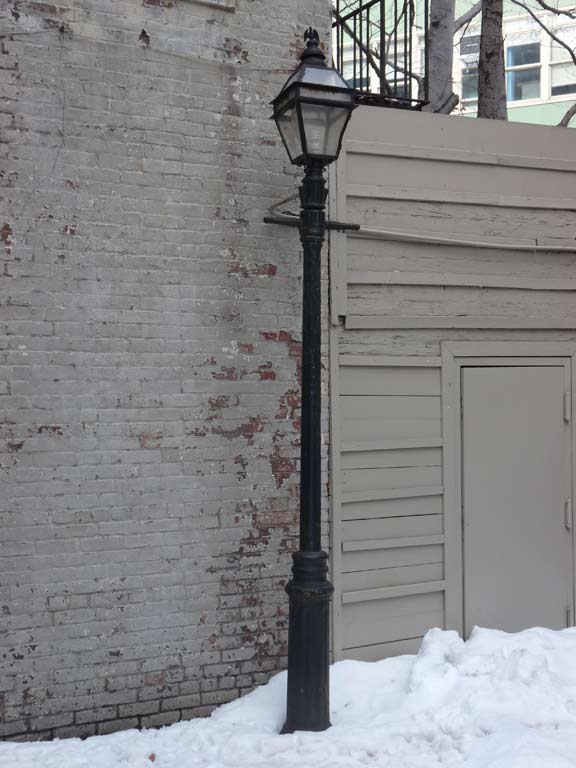

This post at the end of Patchin Place is sometimes cited as “Manhattan’s last gaslight post.” That’s not quite true because there are many, many working gaslamps in front of private residences in the five boroughs. What is true is that this is one of two remaining gaslamp posts that were maintained by the city and lined public streets. (The other remaining one is at Broadway and Isham Street in Inwood.) They were maintained by lamplighters who would position their ladders against the ‘ladder rests’ below the lamp itself. Patchin Place’s gaslamp was converted to electricity as early as the 1920s, according to some accounts.
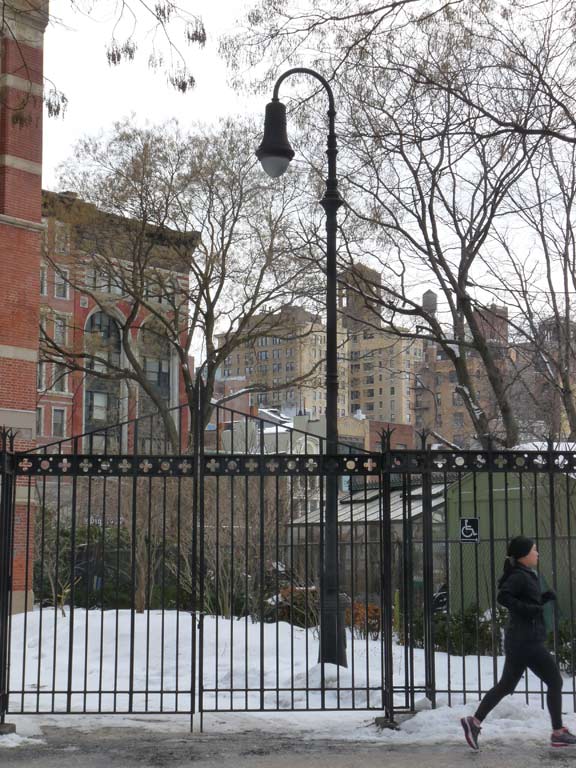
What’s not as publicized is this Type 1 BC bishop crook post, missing its decorative scrollwork, found across the street in the Jefferson Market Library courtyard. This post likely dates to the 1910s. It formerly stood at the corner of West 10th and Patchin, but was moved here about 20 or 25 years ago [as of 2014] with a new retro-style Crook installed in its place.
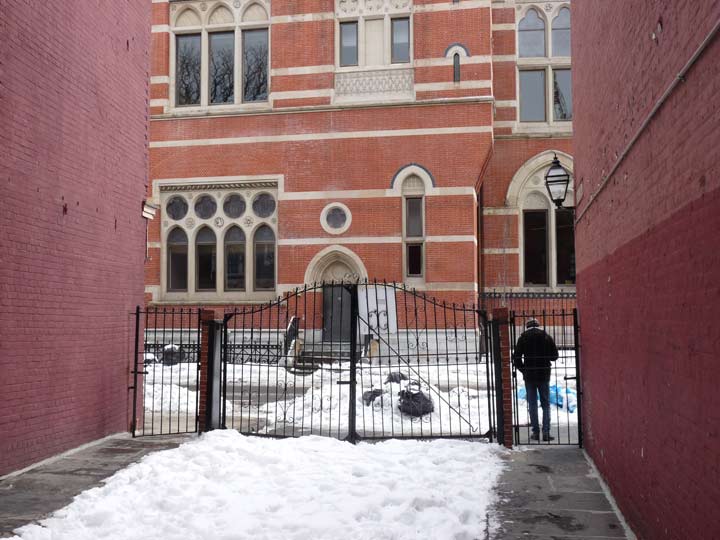
View just inside the gate toward the library.
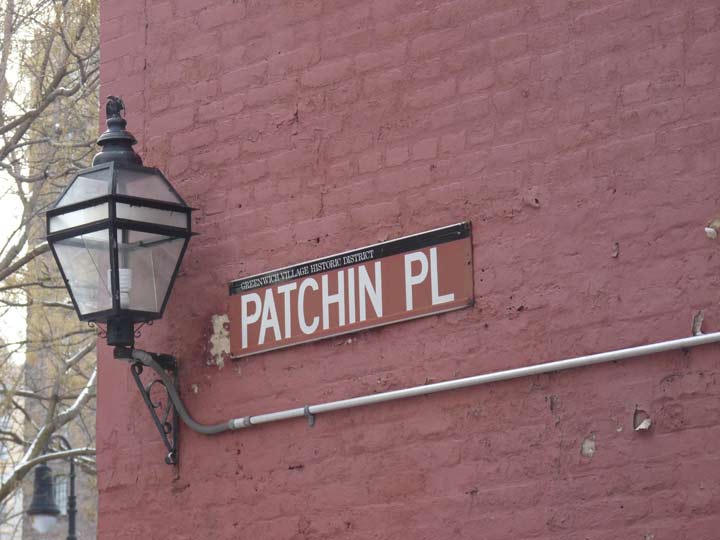
The alley also boasts the only wall lamp in the city of this type.
2/20/14

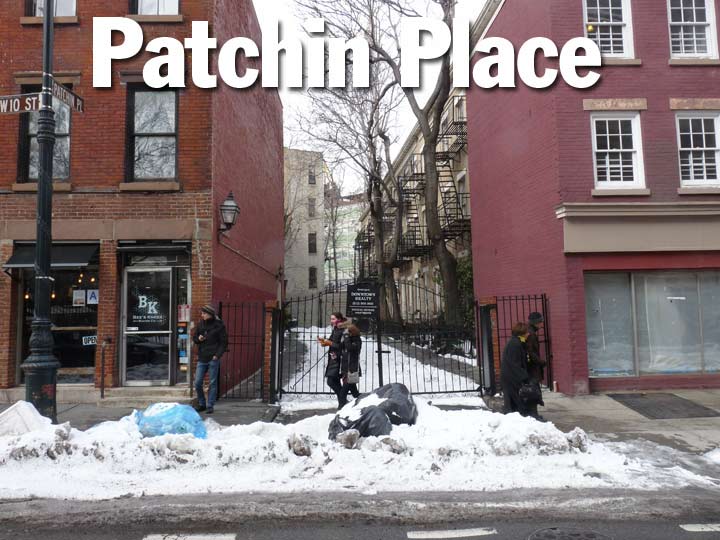
26 comments
Great article, as well as the vintage map, and accompanying photos. I just love the quaintness and charm of this little lane.
Hard to believe that someone like e e cummings lived in Greenwich Village as late as 1962. Fifty years later Gov. Cuomo has declared those like Cummings persona non grata. This winter in NYC has shown how harsh the climate is politically as well as meteorologically.
I agree, very interesting post. In the best live and let live Village ethos I could easily see Reed and Cummings sharing a cuppa. Or maybe not. Just the fact that they shared the same space is enough. The Reds era is an interesting period in American history. Sadly overlooked. I loved the flick and my readings of the era show an alternative path to what became the norm in the country.
Keep that street map showing St Vincents Hospital.
Thank you for your many postings about New York’s past, and how it stands around us, or not, in the present.
The information, in this post and others, has been helpful to develop my Greenwich Village Walking Tour and others at Walk About New York.
Keep up the good work!
Jean Shepherd, radio raconteur, writer, and erstwhile actor also lived in Patchin Place. Some say that was his last residence in NYC. He was an avid HAM radio operator, licensed as K2ORS, and a fellow HAM saw that he erected a “Tri-Bander” metal aerial on the rooftop of his townhouse there. That area of West 10th was just several blocks from the “Limelight” niteclub at Sheridan Square where he had a live broadcast Saturday nights on WOR for many years in the 1960s.
Patchin Place also figures prominently in Pete Hamill’s novel, Tabloid City. I recommend this book to anyone who loves both newspapers and New York.
Acclaimed artist R.A. Blacklock also live at Pachin Place for a fair amount of time.
For anybody who cares about the history of Patchin Place and New York City generally, the novel The Impossible Lives of Greta Wells by Andrew Sean Greer, is a wonderful tribute and a great read.
I am reading this novel right now and had to visit Patchin Place. Oh how I wish I could have lived here back in the hey days.
I apologize for multiple comments. This one and my previous one can be dismissed. My next submission contains an edit. Thanks!
Thank you for the photos and posting. My 3rd great-grandmother was Margaret Score. I located her obituary published in the New York Herald July 2, 1868, which listed her funeral from her late residence, “No. 9 Patchin Place, West Tenth Avenue between Sixth and Greenwich Ave.”
A question! NY city housing sites give dates for the construction of Patchin Place much later, 1889 to 1915 and real estate sites quote this. Why the discrepancy?
This is a great website about the cul-de-sac named Patchin Place.
My step grandmother Margaret Wedesweiler lived at #2 Patchin Place
in the late 1890’s and early 20th century. Her husband Jacob was a chef at the
Waldorf Hotel. She was the landlady at #2 Patchin Place and gave help to the would-be
artists and actors in New York. She was the”Angel of Patchin Place”.
I wonder of this could be Mrs Wiedersweiler or Weidersweiler who was the caretaker or superintendent of Patchin Place and lived there for over forty years?
Hello Mr. Crozier,
This has to be the same person. The name is so similar and not very common.
I was not aware that Mrs. Wedesweiler lived on Patchin Place for so long.
She was very interested in helping the up and coming artists and actors.
A little background on Mrs. Wedesweiler–
Margaretha Schlarp (familysearch.org)
Daughter of Johann Schlarp and Margaretha Hermann
Born April 1, 1854, Spohnheim, Rheinand, Preussen,
Christened April 4, 1858, Sankt Martinus (St. Martin’s?),
Katholisch, Spohnheim (familysearch.org)
Immigrated to New York 1887 (New York Census 1910)
2nd wife of Jakob Wedesweiler, date of marriage November 3, 1887, Manhattan,
New York
Resident of Patchin Place, Greenwich Village, New York
research by Angela Dutra
I lived in Patchin Place #8 as a child in the early 1940s. My father, William Slater Brown, was a close friend of Cummings and is, in fact, the character B in The Enormous Room, Cummings’ memoir of their time in the Norton-Harjes Ambulance Corps, and in the French prison La Ferté Macé in Normandy.
There was a constant stream of interesting people from the art and literary circles coming through. Some whom I remember vividly besides Cummings are Dawn Powell, Djuna Barnes, Malcolm Cowley and of course the ubiquitous Joe Gould who was always looking for a handout.
I stayed in #4 Patchin Place a couple times when my cousin lived there. Had no idea it was historic until I saw the plaques on wall outside the door. I was a kid and thought it was “cool” that tour groups showed up outside sometimes. It always seems like a cool refuge from the City, though I wish I had spent more time appreciating being in the building than I was romping around the City. Glad to see it’s still there and hope it remains for a long, long time.
I’ve been reading a series of books by Rhys Bowen “Molly Murphy mystery” and she has her lead character living in patchin place. I googled it to find out about it. Love the history behind this place. Would recommend this series to mystery readers. Set in the early 20th century
I read that series, too. I saw a lecture online this week that mentioned Patchin Place & I was so thrilled to see it’s a real place. I will be going to visit it for sure.
Just finishing this series now & have been so intrigued by Patchin Place!! Great history!!
My Dad was born in Patchin Place, think #3.
Two Great Aunts also lived there, Lydia and Alvina. They sewed the sequences on costumes for Radio City Music Hall. Remember when a child going to visit them. It was said ee cummings wrote a poem called ‘Lydia’ about her. Researched but never found poem. Recall the women’s prison across the street and women calling out the windows.
The great journalist Edward R. Murrow lived in Patchin Place.
Marguerite Thompson Zorach and her husband William lived just around the corner at 123 10th Avenue for two decades in the early 1900s. I’m not entirely sure if their current building is original—it doesn’t appear to be multifamily, which raises questions. Perhaps that’s a topic for another post.
Marguerite herself was a remarkable figure. Born in Fresno, California, she was among the bold cohort of “American girls” who pursued serious art training in Paris and exhibited at the Salon. Her travels spanned Europe, Africa, and Asia before she returned to the U.S., married William Zorach—despite family resistance—and settled in this storied enclave.
It’s compelling to imagine the creative energy that once filled this neighborhood, shaped by artists like the Zorachs and others who converged here, undoubtedly influencing one another in ways both subtle and profound.
Recommend further reading: https://reidhall.globalcenters.columbia.edu/zorach
Marguerite Thompson Zorach and her husband William lived just around the corner at 123 W 10th St for two decades in the early 1900s. I’m not entirely sure if their current building is original—it doesn’t appear to be multifamily, which raises questions. Perhaps that’s a topic for another post.
Marguerite herself was a remarkable figure. Born in Fresno, California, she was among the bold cohort of “American girls” who pursued serious art training in Paris and exhibited at the Salon. Her travels spanned Europe, Africa, and Asia before she returned to the U.S., married William Zorach—despite family resistance—and settled in this storied enclave.
It’s compelling to imagine the creative energy that once filled this neighborhood, shaped by artists like the Zorachs and others who converged here, undoubtedly influencing one another in ways both subtle and profound.
Recommend further reading: https://reidhall.globalcenters.columbia.edu/zorach